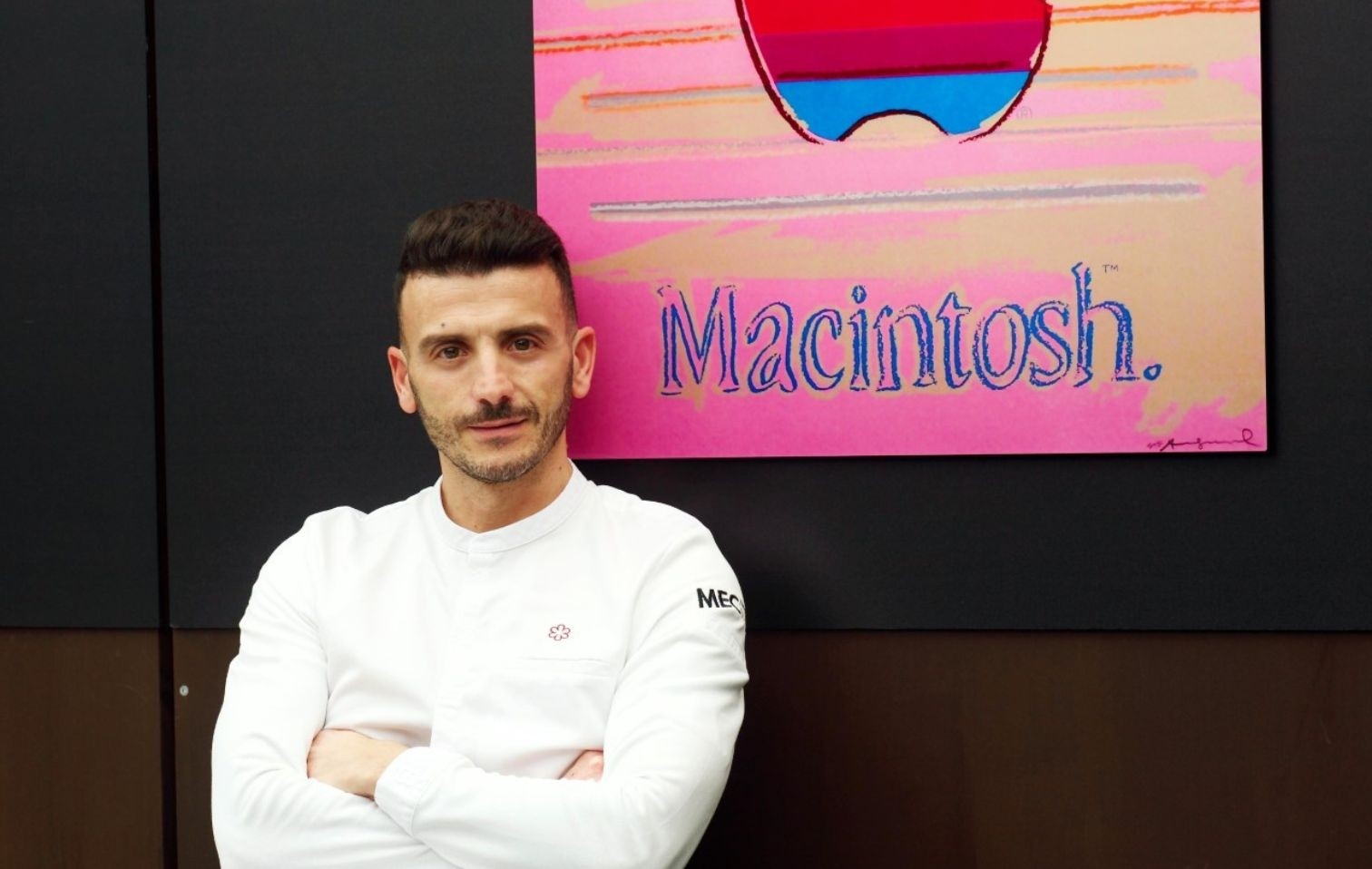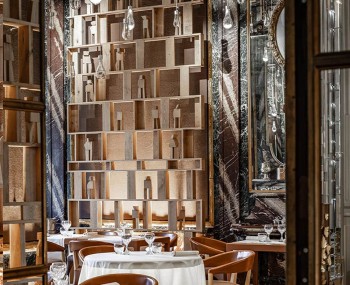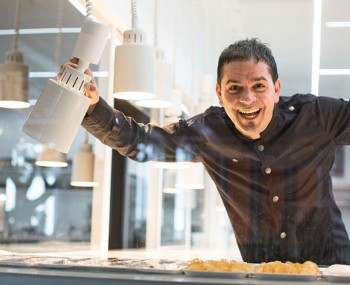Meet Eat Connect: In Palermo, Carmelo Trentacosti combines his vast hotelier experience into a distinctly Sicilian fine dining, set against a spectacular backdrop. It's a kaleidoscope of contrasts: between aristocratic ambiance and old tech relics, popular flair and classical styles.
The restaurant
There was a need that Palermo didn't think it had: the need for fine dining. For almost half a century now in the capital, unlike other tourist-oriented areas in Sicily, there was a lack of high-end dining, which suddenly exploded, taking on two very different faces almost simultaneously: Carmelo Trentacosti's MEC and Mauricio Zillo's Gagini, both awarded stars in 2022 and 2021 respectively, both frequented by a dense local clientele.


The location of the first one sparks expectations beyond measure. You enter through the doorway of Palazzo Castrone Santa Ninfa, in the very central Corso Vittorio Emanuele: a sixteenth-century marvel, whose internal courtyard is dominated by a monumental palm tree, as slender and towering as it is ancient. Here on the first floor, architect and patron Giuseppe Forello has strategically arranged, in the marble halls with frescoed ceilings, his Apple relics, creating a museum of computer history, open to visitors in the morning. At the same time, he opened MEC restaurant, immersed in an enigmatic beauty, animated by contrast.


Carmelo Trentacosti presides here, a familiar face to the people of Palermo. Born in Germany to immigrant parents and returning to the island as a child, he was already cooking with his grandmother and uncle at the age of 12, the latter being a cook at the Italian energy company canteen. This led him to enroll at the Paolo Borsellino Hotel School, a springboard for prestigious experiences, including the Excelsior in Venice, the Grand Hotel in Cortina, and Nino Graziano's Mulinazzo, where he was the right-hand man (but now he teaches himself). Joining the Italian National Chefs Team, he competes in international competitions, including as a pastry chef; then he returns to Sicily with his wife, and from 2012 to 2019, he stays at Villa Igiea.


The meeting with Giuseppe Forello is karmic: a chat is all it takes to reach an agreement. In the frescoed halls, Trentacosti instantly imagines a white tablecloth and a black armchair, as an expression of his cuisine. It will be called MEC, an acronym for Meet Eat Connect, because it connects distant worlds. And while the setup progresses, he studies gastronomy, hospitality, and territory, a university degree where he will graduate in April with a thesis on Bourbon cuisine.

From a luxury five-star hotel to a 24-seat fine dining restaurant, the leap is not short. "Managing a hotel with 120 rooms, which hosts 120 weddings a year and holds 4 restaurants, hones the skills; but already within Villa Igiea, my dream of a gourmet restaurant had come true with Cuvée du Jour, which almost earned a Michelin star in 2018." His second incarnation is here, from scratch and without compromises: everything related to dining has been personally chosen or designed by Trentacosti. At the opening in 2020, ten collaborators followed him from Villa Igiea, including the second chef, Antonio Lo Cicero; while the pastry section, previously overseen by himself personally, is now entrusted to pastry chef Gianluca Bruno. In the dining room, Alessandro Comella, arriving from Cracco, is the manager and sommelier, in charge of a cellar that has expanded to 750 labels, including many from Sicily and France, but also from the New World.

The dishes
In the bread basket, there's sourdough loaf, onion-marinated breadsticks, soon to come, a sfincione croissant with anchovy oil or butter, imprinted with a small apple. You can dine à la carte, with five dishes per course, or choose between two tasting menus: Contaminations (140 euros) and Vegetable Frontiers (125 euros), with the assurance that the ingredients will be extraordinary regardless. "Seven years ago, with a consultant from Rome, Manuela Mancino, I traveled around Sicily by car in search of niche products.

We found many: the goat robiola from Joppolo Giancaxio, the hairy watermelon from Partanna, the Vastedda del Belice cheese from Calogero Cangemi, Sicilian citrus fruits, and eggs from Sicilian breed chickens (the Caltanissetta horned breed, almost extinct, fed on Sicilian wheat) from Marineo, my hometown. Then there's the wild fennel, which grows spontaneously on the hills, and local vegetables, often from niche farmers." The connection to the computer universe takes on symbolic forms, obtained from silicone molds. This is the case with the canned Caponata, shaped like the classic bitten apple.

"When a child leaves home, in Sicily, the mother packs preserves for him. Caponata and tomato sauce are indispensable. From there came the idea of a non-seasonal product, preserved in a protective atmosphere, which is spread on the plate and dusted with Modica chocolate, in the Arab style. It's eaten by dipping an olive brioche and double tomato concentrate, which completes the making of the dish. I find that fennel is a vegetable that is undervalued in my opinion, which here is practically only eaten raw. But I like to extract the most from the product, so I obtain different textures out of it, such as cream, flan, and air, with the vegetable's fronds, the right acidic contrast, and popcorn." Fusilloni with broccoli reimagine the classic recipe, but without raisins or pine nuts.

They are entirely cooked in a skillet, starting from raw, and portioned in the dining room, with a shaving of truffle and a veil of mornay sauce to lighten it up. A unique baked pasta, which required extensive technical study. The artichoke dish stems from the chef's son's vision, Filippo, as he greedily peels apart the charcoal-roasted buds. Thus, a casing of smoky petals, surrounding the artichoke cream, yolk, and truffle, atop a cheese fondue, blending popular flair with fine dining standards.

The recommendation is to stop the cheese cart at the table, containing 20 different varieties all from Sicily, served with dried and fresh fruit, mustard, honey, and 3 types of bread (raisin brioche, olive bread, and carob bread). "Almost a signature" is the cassata, made of ricotta and pistachio mousse (which will become ice creams in summer), cocoa dacquoise, and orange gelée, without excessive sweetness.

Contacts
MEC Restaurant
Via Vittorio Emanuele, 452, 90134 Palermo PA
Phone: 347 753 2005











